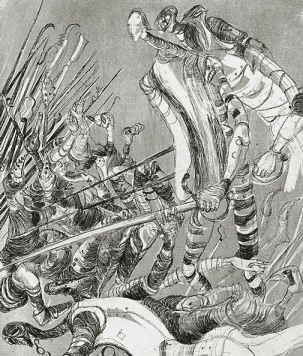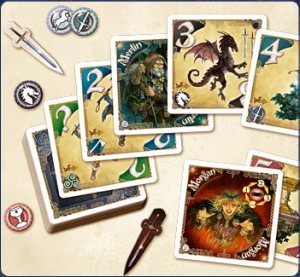Therefore, said Arthur unto Sir Bedivere, take thou Excalibur, my good sword, and go with it to yonder water side, and when thou comest there I charge thee throw my sword in that water, and come again and tell me what thou there seest. My lord, said Bedivere, your commandment shall be done, and lightly bring you word again.
- Sir Thomas Malory, Le Morte d?Arthur, Book XXI, Chapter V (1485)
?Listen, strange women lying in ponds distributing swords is no basis for a system of government. Supreme executive power derives from a mandate from the masses, not from some farcical aquatic ceremony.?
- Dennis (Michael Palin) ? Monty Python and the Holy Grail (1975)

Who knew King Arthur was so dark?
My kids are incredible readers of actual books. They will sit in the car, both of their faces planted between the pages of some story, and devour them in hours. I, on the other hand, was a reluctant reader much of my life, until now. But while I currently have the motivation, I lack the time. Life is ironic like that. I do not lack in good material, however, as I am a prolific book buyer; constantly buying books that look great, and then proceeding to never read them. Eventually, when things slow down for me in a few decades, I will have come serious catching up to do.
My mother and grandmother were big readers as well. One of the books I remember my mother reading when I was much younger was T.H. White?s ?The Once and Future King.? A modern day telling (it was written in the late 1930s) of the Arthurian Legend. Because of her great love for the book, and its subject matter, I was exposed to tales of knights and damsels and magical swords and wizards. While I liked the Arthurian stories, for me, it was cooler to read Tolkien because there wasn?t so much kiss-y-face. That was, until my mom and grandmother took me to see Excalibur. An early cable TV staple, I must have watched it 150 times before I turned 13. What nerdy child of the 70s didn?t know by heart the incantation Merlin invoked to unleash all measure of nastiness upon Avalon: ?An?il nathrach, ortha bh?is is beatha, do ch?al d?anaimh.?

Pretty box and components.
Arthur and his retinue have since held sway with me as part of that primordial-melting-pot-formative-back-story that underlies my interests in fantasy fiction and gaming. However, surprisingly, I have been reluctant to delve into any Arthur-themed gaming material until recently, when I picked up Days Of Wonder?s Shadows Over Camelot, The Card Game. I thought it would be a good entr?e to its source material, the board game, at a very reasonable price point of $25.00. The kids and I broke it out and played quite a few games, and I have to admit, I am hooked.
Background/Story of the Game
The sons and daughters of the original Knights of the Round Table must assemble, Avengers! Style, to protect King Arthur?s realm from numerous threats. The players must work together to complete quests before the game?s danger level gets too high. But alas, they are beset by a traitor amongst their number who secretly works against them to bring about their ultimate ruin. The ?quests,? include quelling internal rebellions from the Saxons and Picts, regaining Excalibur, slaying a deadly dragon, or going on the ultimate quest?for the Holy Grail itself!
Object of the Game
The ultimate goal is to collect seven ?white swords,? representative of successful quests, whereby the players will have cooperatively won the game. If instead, the players amass seven ?black swords,? they failed the kingdom and their ancestors, and all of them lose, unless one of their number was a traitor, in which case, that player is the winner.
Game Components
62 square shaped Rumor cards
9 standard size Knight cards
9 standard size Loyalty cards
16 cardboard punch-out Swords
10 cardboard punch-out faction/quest Tokens

This is everything in the box.
The game comes in a small box with a plastic insert that holds all the components neatly. The main cards in the game, the Rumor Cards, are square shaped, and so, cannot be readily sleeved. This is somewhat of a negative, as I obsessively protect and preserve all my game components. The other cards are more traditionally shaped, however, and can be sleeved, although they do not see the same amount of action as the Rumor deck.
In addition, there are 16 cardboard punch-piece swords, with white/black sides, used to track players? successes or failures, and chits used to track certain in-game card effects.
Gameplay
Knights go on quests, and that is the core theme of this game. ?Quests? are represented by five types/suits of cards (in the ?rumor deck?). Each card bears a number from 1 to 4 or a question mark (whose value is set by the number of other ??? cards in the same suit), representing the ?Rumor Value? of the card, as well as 1-3 swords, representing the level of difficulty and resulting victory points for a successful run. These rumor cards cards are shuffled together with Morgan (le Fay) cards (which make the quests harder to keep track of, represented by ?curses? on the players), and Merlin cards (which provide a benefit to the players, removing some aspects of curses). The Rumor Cards form the main deck used by the players in the game, which is set in the center of the table.
At the start of the game, each player receives a secret loyalty card which may cast one of them as traitor. From there, on their turn, each player either: (1) reveals a rumor card; (2) attempts a quest; or (3) accuses a fellow knight as being the traitor.

Rumor cards for Dragons and Picts. Note the rumor value and rewards differ.
To reveal a rumor card, the top card of the rumor deck is placed face up onto a revealed stack of cards. If a quest card, players must keep track of the total rumor value of cards from that suit. You may not look at any cards other than the top card of the discard pile. Players try to attempt a quest when the total rumor value of cards in that suit is 11, 12 or 13. Any lower, and they arrived too soon; any higher, and they arrived too late, and the quest has failed.
To attempt a quest on their turn, the player ?runs? the quest determined by the suit of the top card of the rumor deck?s discard stack. The player reveals all cards in the deck, and if the sum of that specific suit/quest is 11-13, then the players succeed, dispelling the rumors, and receive 1-3 white swords, as shown on the specific quest cards. If the rumor value is lower than 11, they receive one black sword for their embarrassing failure. If higher than 13, they get a number of black swords based on the success value of the suit. All other quests in the stack are checked to see whether the players allowed them to fester too long, and if any of their values total over 13, the players receive another ?failure? black sword.

Morgana and Vivian ?special? cards from the Rumor Deck add flavor and increase the difficulty of quests.
But, it is not just simple card memory at work. The Morgan and Merlin cards will make the quests much harder, or easier, either by multiplying the values of the quest cards? rumor value, or taking out the highest value card in a particular suit, depending on the numerous different Morgan/Merlin cards in the game, among many other nefarious or beneficent effects.
Once at least three swords have been claimed, whatever the color, a player may accuse another player of being the traitor, winning a reward of one white sword if correct and a penalty of one black sword if not. Also, there are ?Knights to the Rescue? cards, representing the personas of the original Round Table members, Arthur, Galahad, Gawain, and others, who provide great aid to the players after a failed quest.
Thoughts/Opinions
For fans of ?semi-cooperative with a twist,? this game delivers. The memory skills required to track the various different types of quests, special Merlin and Morgan cards, and the face values on the cards themselves is challenging, whether for three or four people, or more. Add to that the suspicion your neighbor knights are possibly traitors, and you are constantly on your toes. Like classic suit based games where card memory skills are rewarded, the game tests the memory banks, and keeps players engaged cooperatively. Players must develop a system to deal with the rumor cards, keep score of the accumulating values in differing suits and the Merlin/Morgan effects, yet still avoid exposure to a cunning schemer amongst their number who makes it appear they were all merely unlucky with a minor bookkeeping error that resulted in a failed quest.
The game plays through in about 15-30 minutes, and is demanding at first, then gets very strategic with repeat plays. There is just enough mental calculus to make it a challenge, yet not an insurmountable one. The Arthurian theme plays well with the rumor deck and quests, and the ?Knight to the Rescue? cards add a great deal of flavor, depth and advanced gameplay. The art is good and the components are all high quality.
Conclusion
 Having played the card game, and other Days of Wonder offerings, I am definitely going to give the board game a look. Days of Wonder have a solid record of producing quality products, and this one is no different. I will definitely share my thoughts on the board game once I have a chance to pull my credit card from the stone known as ?Christmas Spending.? Happy holiday season and New Year every one!
Having played the card game, and other Days of Wonder offerings, I am definitely going to give the board game a look. Days of Wonder have a solid record of producing quality products, and this one is no different. I will definitely share my thoughts on the board game once I have a chance to pull my credit card from the stone known as ?Christmas Spending.? Happy holiday season and New Year every one!
Like this:
Be the first to like this.
2012 sports illustrated swimsuit same day flower delivery valentines day westminster dog show valentines day cards hallmark grammy winners
No comments:
Post a Comment